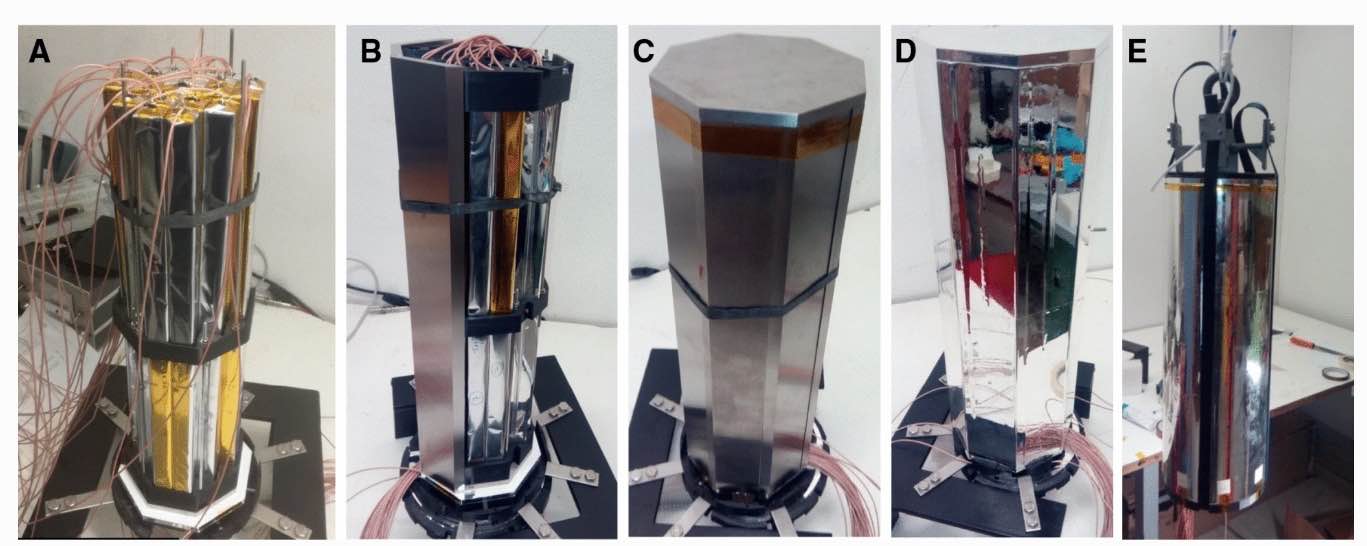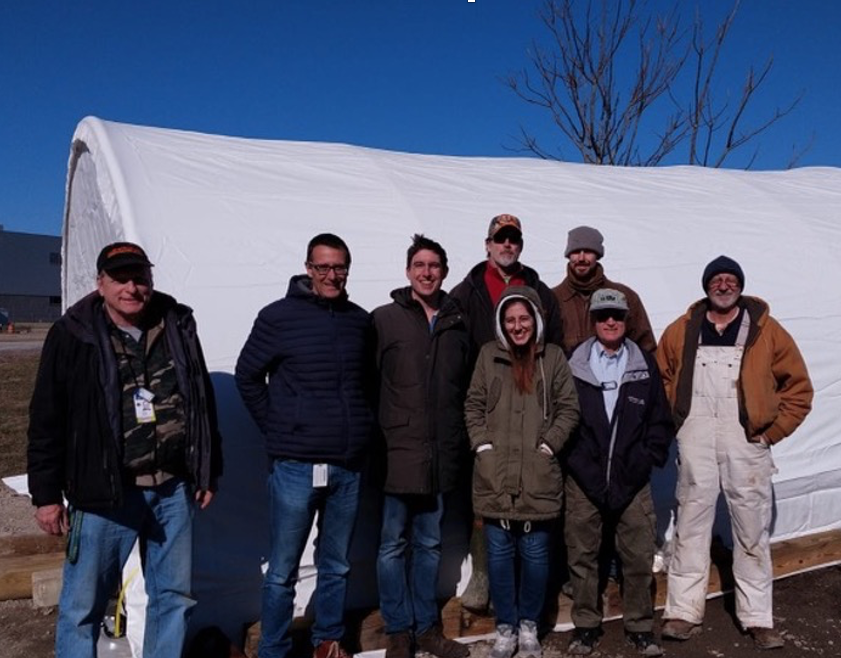Collaborators stand outside the tent hosting the BDX-MINI electronics and covering the well where the detector was installed. Image: BDX Collaboration
A mini version of the Beam Dump eXperiment (BDX), which will search for light dark matter particles, has successfully completed collecting data.
NEWPORT NEWS, VA – Although it’s thought that dark matter makes up most of the universe, no one has ever seen, identified or produced it. The forthcoming Beam Dump eXperiment at the U.S. Department of Energy’s Thomas Jefferson National Accelerator Facility hopes to be the first to detect a particle of dark matter — a feat that could improve our understanding of the composition of the universe.
While many experiments to date search for existing dark matter, BDX will use Jefferson Lab’s Continuous Electron Beam Accelerator Facility — a DOE Office of Science user facility that produces the most powerful electron beam in the world today — to potentially produce dark matter in the lab. The intensity of CEBAF could allow the Beam Dump eXperiment, most commonly referred to as BDX, to surpass the discovery potential of other dark matter experiments.
Before the full-fledged BDX begins, the BDX collaboration ran a miniature version of the experiment called BDX-MINI. The goal was to demonstrate the feasibility of conducting such an ambitious experiment.
After continuously operating for about six months in 2019-2020, BDX-MINI successfully completed data collection. Its detector performed robustly despite operating outdoors in a field tent.
“The stability of the detector is not trivial, because I want to stress that we ran not in an experimental hall, but in a tent,” said Mariangela Bondi, a postdoctoral researcher at Istituto Nazionale di Fisica Nucleare in Genoa, Italy, who has worked on BDX since its first proposal.
“BDX-MINI is the first electron beam dump experiment optimized to search for light dark matter,” Bondi said. “The goal for BDX-MINI is to demonstrate that this kind of experiment is possible.”
A Miniature Version of the Beam Dump eXperiment
The BDX collaboration is currently analyzing data from BDX-MINI and hopes to have results within the year. Because BDX-MINI was smaller and used a lower-energy electron beam than BDX (2.2 GeV beam versus 10 GeV), it doesn’t have the same discovery potential, meaning the parameter space accessible by the experiment has already been excluded by previous measurements.
Instead, BDX-MINI validates the detector design for BDX. Other than size and some minor technical differences, the BDX-MINI detector and BDX detector are conceptually the same.
“It was very important for us to conduct BDX-MINI, because we proved that we are able to do the full BDX,” said Marzio De Napoli, staff researcher at the Instituto Nazionale di Fisica Nucleare in Catania, Italy, and a co-spokesperson of BDX. De Napoli has also been involved in the experiment since its conception. “Before a concert, you have to tune your musical instruments and be sure that everything works. It was really useful for us to tune the details of the experiment. It is a very important step for the final BDX.”
More information about BDX-MINI was recently published in a paper that describes the detector and its performance. BDX-MINI also allowed the collaborators to build an analysis framework that could be used for BDX. The collaborators expect to publish another paper soon with fully analyzed results from the BDX-MINI run.
Making Dark Matter
For both BDX-MINI and BDX, the target for Jefferson Lab’s electron beam is Hall A’s beam dump, which is a piece of aluminum cooled with water that is used to dampen and halt the CEBAF residual electron beam. It’s thought that the interaction of the beam electrons with the beam dump could produce dark matter particles through a not-yet-discovered fifth force.
There are four known forces: gravitational, electromagnetic, strong and weak. But it’s possible that dark matter feels a fifth force that is mathematically similar to the electromagnetic force. Every force is mediated by a particle. If this fifth force exists, its mediator is called a dark photon.
“This dark photon can be kinematically mixed with a standard photon. And the result is a sort of portal between standard particles and dark matter,” Bondi said.
Electrons from the beam interact with the beam dump to possibly produce dark photons. These dark photons could decay into light dark matter particles.
Hall A’s beam dump is underground, in line with the beam. The BDX detector will be downstream of the beam dump, hoping to catch light dark matter particles. However, the probability of producing a dark photon that decays into dark matter is extremely low.

The different components of BDX-MINI are shown: (a) fully assembled detector and (b&c) tungsten shielding, (d) the inner veto, and (e) the outer veto
“We are looking for very rare processes,” De Napoli said. That’s why BDX needs CEBAF’s intense electron beam, because more electrons interacting with the beam dump equals more chances for a very low probability event to happen. “The ability of the intense beam is really a unique feature of Jefferson Lab’s CEBAF accelerator, and the reason we want to do the experiment there.”
Interaction between the beam and beam dump is more likely to produce well-known standard particles. Shielding between the beam dump and the detector will stop most of these more familiar particles from reaching the detector.
BDX-MINI made do with existing shielding, which was sufficient for the scaled-down experiment, but BDX will require optimized shielding between the dump and detector.
A Look Ahead
The ambitious experiment has been approved by the Program Advisory Committee, a rotating group of highly regarded nuclear physicists who carefully review and determine the experiments that will be conducted at Jefferson Lab. The BDX-MINI run served as a proof of principle for the full-fledged BDX, and it’s hoped that this success will help the BDX collaboration secure the additional funding it will need to stage the experiment.
In addition to better shielding, BDX will also require new infrastructure, including a new subterranean hall downstream of the existing Hall A beam dump.
“We need something more stable than a tent for the final BDX,” De Napoli said.
Once that is built and the parts are installed, the collaborators will begin data collection for BDX.
“We are ready,” he said.
Further Reading
Battaglieri, M., Bisio, P., Bondí, M. et al. “The BDX-MINI detector for Light Dark Matter search at JLab.” Eur. Phys. J. C 81, 164 (2021). https://doi.org/10.1140/epjc/s10052-021-08957-5
By Chris Patrick
Contact: Kandice Carter, Jefferson Lab Communications Office, kcarter@jlab.org


